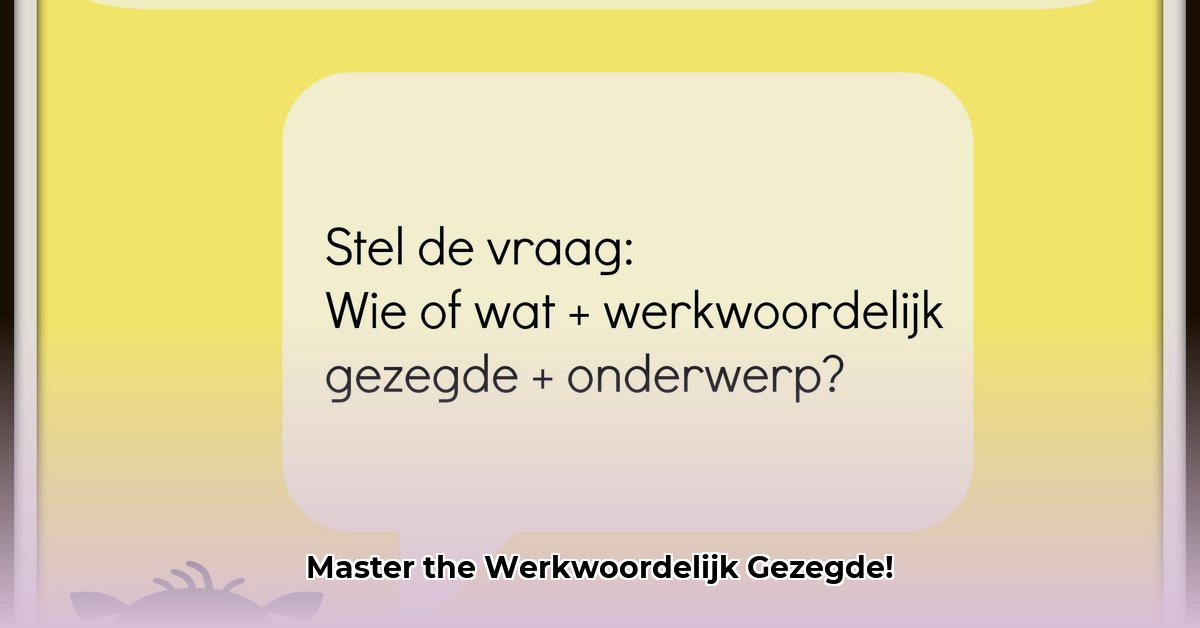
Mastering the Werkwoordelijk Gezegde: Your Comprehensive Guide
Eish, tackling Dutch grammar can feel like trying to untangle a set of very complicated fishing nets! But don't you worry, bru! This guide will make finding the werkwoordelijk gezegde (verbal predicate) a breeze. We'll break it down, step-by-step, so even if you're a complete beginner, you'll be identifying verbal predicates like a pro in no time. Let's get started!
Identifying the Persoonsvorm (Main Verb)
First things first: find the persoonsvorm (conjugated verb). This is the verb that tells us who is doing the action and when. Think of it as the sentence’s engine – it drives the whole thing. In the sentence "Hy eet 'n appel" ("He eats an apple"), "eet" (eats) is your persoonsvorm. Piece of cake, right? But hold your horses – things get more interesting!
Unpacking the Werkwoordelijk Gezegde: More Than Just the Main Verb
The werkwoordelijk gezegde often includes more than just the persoonsvorm. It can also include other verb-related components, like infinitives (e.g., "te loop" - to walk) and past participles (e.g., "geëet" - eaten). These all work together to form the full verbal action of the sentence. For example, in "Sy het begin te sing" ("She started to sing"), "te sing" is part of the werkwoordelijk gezegde because it completes the description of the action.
Navigating Complex Sentences: The Tricky Bits
Now for the fun part – the tricky sentences! Let's tackle some common challenges.
1. Phrasal Verbs: A United Front
Phrasal verbs – those pesky verb combinations – act as a single unit. Don't try to split them up! In "Hy kyk op" ("He looks up"), "kyk op" forms a single werkwoordelijk gezegde.
2. Compound Verbs (Werkwoordelijke Uitdrukkingen): A Family Affair
These are verbs made up of multiple words that act as one, a single unit. In "Hy het opgegee" ("He gave up"), "opgegee" is your werkwoordelijk gezegde – it's one compact unit of meaning, even if it looks longer.
3. Subordinate Clauses: Sentences Within Sentences
Subordinate clauses – sentences within sentences – each have their own werkwoordelijk gezegde. In "Hy het gesê dat hy sou slaap" ("He said that he would sleep"), we have two: "het gesê" (he said) and "sou slaap" (would sleep). That's double the fun!
4. Passive Voice: A Different Perspective
In the passive voice, the werkwoordelijk gezegde includes the helping verb (like "word", "is", "was") and the past participle. In "Die boek is gelees" ("The book was read"), "is gelees" makes up the whole werkwoordelijk gezegde. Remember, even here, all parts are necessary to show the full action.
Werkwoordelijk Gezegde vs. Naamwoordelijk Gezegde: Spot the Difference!
It's crucial to avoid confusing the werkwoordelijk gezegde with the naamwoordelijk gezegde (nominal predicate). A naamwoordelijk gezegde uses a linking verb (a kopula) and a noun or adjective to describe the subject. It tells us what something is, not what it does. For example, "Hy is 'n dokter" ("He is a doctor") uses a naamwoordelijk gezegde, while "Hy werk as 'n dokter" ("He works as a doctor") uses a werkwoordelijk gezegde.
Time for Some Practice!
Test your skills! Identify the werkwoordelijk gezegde in these sentences:
- Die hond blaf hard.
- Sy het 'n koppie koffie gedrink.
- Hulle sal môre reis.
- Die huis is gebou.
- Hy het probeer wegkruip.
Answers:
- blaf
- het gedrink
- sal reis
- is gebou
- het probeer wegkruip
Key Takeaways: A Quick Recap
- Find the persoonsvorm first – it's your anchor!
- Remember that the werkwoordelijk gezegde might include more than just the main verb.
- Master the trickier parts: phrasal verbs, compound verbs, subordinate clauses, and passive voice.
- Don't confuse the werkwoordelijk gezegde with the naamwoordelijk gezegde.
- Practice, practice, practice! The more you do, the easier it gets.
By following these steps and practicing regularly, you'll be a werkwoordelijk gezegde expert in no time! Sterkte! (Good luck!)